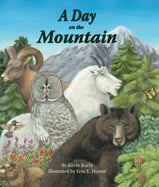Alignment to Standards for GA

| Grade | Number | Standard |
|---|---|---|
| 1 | S1CS4. c | Compare very different sizes, weights, ages (baby/adult), and speeds (fast/slow) of both human made and natural things. |
| 1 | S1L1. d. | Compare and describe various animalsãappearance, motion, growth, basic needs. |
| 1 | SS1G3 c. | Identify and describe landforms (mountains, deserts, valleys, plains, plateaus, and coasts). |
| 3 | S3L1. | Students will investigate the habitats of different organisms and the dependence of organisms on their habitat. |
| 3 | SS3G1b. | Identify major mountain ranges of the United States of America: Appalachian, Rocky. |
| 4 | S4E4.d. | Differentiate between weather and climate. |
| 4 | S4L1. | Students will describe the roles of organisms and the flow of energy within an ecosystem. |
| 4 | S4L1. a. | Identify the roles of producers, consumers, and decomposers in a community. |
| 4 | S4L2. | identify factors that affect the survival or extinction of organisms such as adaptation, variation of behaviors (hibernation), and external features (camouflage and protection). |
| 4 | S4L2. a. | Identify external features of organisms that allow them to survive or reproduce better than organisms that do not have these features (for example: camouflage, use of hibernation, protection, etc.). |
| 5 | S5L1. | classify organisms into groups and relate how they determined the groups with how and why scientists use classification. |
| 5 | S5L1. a. | Demonstrate how animals are sorted into groups (vertebrate and invertebrate) and how vertebrates are sorted into groups (fish, amphibian, reptile, bird, and mammal). |
| 5 | S5L2. | Students will recognize that offspring can resemble parents in inherited traits and learned behaviors. |
| 5 | S5L2. a. | Compare and contrast the characteristics of learned behaviors and of inherited traits. |
| K | SKCS5.A | Describe and compare things in terms of number, shape, texture, size, weight, color, and motion. |
| K | SKL1. b | Group animals according to their observable features such as appearance, size, motion, where it lives, etc. (Example: A green frog has four legs and hops. A rabbit also hops.) |
| K | SKL2. | Students will compare the similarities and differences in groups of organisms. |
| K | SKL2. a | Explain the similarities and differences in animals. (color, size, appearance, etc.) |